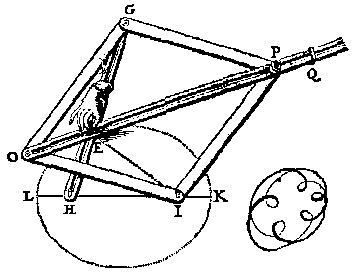- About MAA
- Membership
- MAA Publications
- Periodicals
- Blogs
- MAA Book Series
- MAA Press (an imprint of the AMS)
- MAA Notes
- MAA Reviews
- Mathematical Communication
- Information for Libraries
- Author Resources
- Advertise with MAA
- Meetings
- Competitions
- Programs
- Communities
- MAA Sections
- SIGMAA
- MAA Connect
- Students
- MAA Awards
- Awards Booklets
- Writing Awards
- Teaching Awards
- Service Awards
- Research Awards
- Lecture Awards
- Putnam Competition Individual and Team Winners
- D. E. Shaw Group AMC 8 Awards & Certificates
- Maryam Mirzakhani AMC 10 A Awards & Certificates
- Two Sigma AMC 10 B Awards & Certificates
- Jane Street AMC 12 A Awards & Certificates
- Akamai AMC 12 B Awards & Certificates
- High School Teachers
- News
You are here
Van Schooten's Ruler Constructions - Overview and Problem I
In this article, we mean to discuss the topics from Book II of van Schooten's Exercitationum mathematicarum libri quinque, but first it would be a good idea to look at the book as a whole.
Book I is a fairly standard review of arithmetic and ordinary geometry.
Book II contains the ruler constructions that we will get to later.
In Book III, van Schooten tries to reconstruct some of the works of Apollonius on plane loci. This was an important research topic of the time, and both Fermat and Descartes devoted a lot of effort to it as well. As usual, van Schooten is about 15 years late, though.

Ellipse drawer from Book IV of van Schooten's Exercitationes mathematicae
Book IV contains van Schooten’s best known work. Its title is “Organica conicarum sectionum”, or “Instruments of conic sections.” The word “organica” is more closely related to the organ as a musical instrument than to the “organic” we sometimes encounter in chemistry or agriculture. As the title suggests, the chapter describes a variety of beautiful instruments for drawing the various conic sections. One of several mechanisms for drawing a parabola is shown on the preceding page of this article, and another for drawing an ellipse is pictured here. All of the instruments are shown being operated by elegant disembodied hands, sometimes showing the cuffs of beautifully ruffled sleeves fashionable at the time. Several of the illustrations include beautiful and irrelevant doodles, like the rosette beside the ellipse machine. For animated versions of van Schooten's parabola and ellipse drawers, see Figures 2, 6, and 8 in the module "Curve Drawing Then and Now" in the Convergence article, "Historical Activities for the Calculus Classroom."
Finally, Book V is titled “Sectiones triginta miscellaneas”, or Thirty miscellaneous sections. In these sections, van Schooten carefully develops the combinatorial principles of counting. It is probably his best work, and it provides a complete foundation for the work of Huygens that follows in the appendix.
Then, van Schooten uses these new counting principles to re-discover the two new pairs of amicable numbers that Fermat and Descartes had discovered fifteen years earlier. Remember that a pair of numbers is amicable if the proper factors of one number add up to the other, and vice versa. For 2000 years, 284 and 220 were the only known pair of amicable numbers. Just a couple of years apart, Fermat and Descartes each discovered another pair. In fact, those two pairs had been discovered a couple of centuries earlier by Arab mathematicians. Van Schooten, of course, knew about the pairs that Fermat and Descartes had discovered, but his approach showed how both pairs could be discovered using the same method. It gave hope that more pairs could be discovered in the same way. Alas, the technique was a dead end, and no new amicable pairs would be discovered for another hundred years.
We return to Book II, “Constructio problematium simplicium geometricorum”, Solution of simple problems of geometry. Van Schooten gives us three postulates. One may
- connect two points with a straight line,
- extend a line, and
- copy a line onto another.
We might call these “ruler constructions”, because we are not allowed to use a compass in the geometric constructions. It might be more rigorous to call them “straightedge constructions,” because we are not allowed to use the instrument to measure anything.
Postulate 3 makes van Schooten’s ruler more powerful than Euclid’s ruler was. We are allowed to use our ruler to copy the length of one line segment onto another line. The postulate does not tell us how to do this, only that it is possible to do it. In practice, we can copy a segment by making a mark on the ruler.
Van Schooten gives us his ruler constructions as a series of ten problems, with solutions. For some problems, he gives two or more solutions. He begins with bisecting a given angle.
Problem I. Given a rectilinear angle BAC, to cut it into two equal pieces.
Next:
Details of first solution to Problem I
Quicker version of first solution to Problem I (verbatim translation of van Schooten’s solution)
C. Edward Sandifer, "Van Schooten's Ruler Constructions - Overview and Problem I," Convergence (August 2010)




